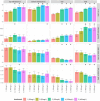Optimal nitrogen rates and clonal effects on cannabinoid yields of medicinal cannabis
- PMID: 40210892
- PMCID: PMC11985917
- DOI: 10.1038/s41598-025-96761-6
Optimal nitrogen rates and clonal effects on cannabinoid yields of medicinal cannabis
Abstract
Nitrogen (N) nutrition and germplasm of clones can influence biomass and cannabinoid concentration in medicinal cannabis. However, there are discrepancies on the optimal nitrogen (N) application rate at the flowering stage to achieve maximum yield and if, or how, this interacts with clones from different seed lines of the same genotype. This research examined the relationship between N application rate, concentration of cannabinoids and biomass yield of a CBD-type medicinal cannabis cultivar in clones propagated from five different seed lines (hereafter referred to as clones). Clonal rooted cuttings were propagated from five mother plants germinated from seeds of cultivar 'Tas1'. Five N levels (30, 90, 160, 240 and 400 mg/L N) were imposed at the start of the inflorescence period and continued until harvest eight weeks later. Some pollen contamination occurred during the trial so that seed biomass was assessed for each plant and included in statistical analysis. Weight of total biomass, leaves and inflorescence (from upper and lower canopy positions), N%, and cannabinoid concentrations were measured after the harvest. Results indicated that increasing N supply generated a clear upward trend in inflorescence biomass that peaked at 160 mg/L N after which it did not significantly change, while leaf biomass steadily increased with N. Delta9-tetrahydrocannabinol (THC) and cannabidiol (CBD) concentrations decreased significantly with increasing N concentration in leaves with a similar, but non-significant, trend for inflorescences. The CBD to THC ratio increased with increased N. Clone source was strongly correlated with cannabinoid concentration, but not leaf, inflorescence or total biomass, across all N treatments. Clones 13 and 27 developed greater cannabinoid concentrations relative to clones 18 and 26 irrespective of N treatment. Pollen contamination induced seed development that comprised up to 5% of inflorescence biomass dry weight but this did not significantly affect whole-plant biomass, N accumulation (N%), or cannabinoid concentration. These findings provide valuable insights for improving cannabinoid yield in this widely cultivated plant species.
Keywords: CBD; Fertigation; Inflorescence; Nitrogen nutrition; Pollen contamination; THC.
© 2025. The Author(s).
Conflict of interest statement
Declarations. Competing interests: The authors declare no competing interests. Ethical approval: The research was conducted under a medicinal cannabis licence and permit issued to Martha Jane Medical by the Australian Office of Drug Control and an industrial hemp licence issued to the University of Tasmania under the Tasmanian hemp legislative framework. The plant collection and use were in accordance with all the relevant institutional, national, and international guidelines and legislation. Permissions or licenses were obtained for the collection of plant material, and the voucher specimen was stored at the University of Tasmania under licence number IHR081. All the original plant material (seeds) used in this research was provided by its commercial owner, Martha Jane Medical, Australia.
Figures



Similar articles
-
Investigating how nitrogen nutrition and pruning impacts on CBD and THC concentration and plant biomass of Cannabis sativa.Sci Rep. 2023 Nov 9;13(1):19533. doi: 10.1038/s41598-023-46369-5. Sci Rep. 2023. PMID: 37945596 Free PMC article.
-
The effects of plant density and duration of vegetative growth phase on agronomic traits of medicinal cannabis (Cannabis sativa L.): A regression analysis.PLoS One. 2024 Dec 30;19(12):e0315951. doi: 10.1371/journal.pone.0315951. eCollection 2024. PLoS One. 2024. PMID: 39774473 Free PMC article.
-
Effect of augmented nutrient composition and fertigation system on biomass yield and cannabinoid content of medicinal cannabis (Cannabis sativa L.) cultivation.Front Plant Sci. 2024 Jan 24;15:1322824. doi: 10.3389/fpls.2024.1322824. eCollection 2024. Front Plant Sci. 2024. PMID: 38328699 Free PMC article.
-
Medicinal cannabis for psychiatric disorders: a clinically-focused systematic review.BMC Psychiatry. 2020 Jan 16;20(1):24. doi: 10.1186/s12888-019-2409-8. BMC Psychiatry. 2020. PMID: 31948424 Free PMC article.
-
Therapeutic Potential of Cannabis, Cannabidiol, and Cannabinoid-Based Pharmaceuticals.Pharmacology. 2022;107(3-4):131-149. doi: 10.1159/000521683. Epub 2022 Jan 28. Pharmacology. 2022. PMID: 35093949 Review.
References
-
- Amaducci, S. & Gusovius, H. J. Hemp: Cultivation, Extraction and Processing. in Industrial Applications of Natural Fibres 109–134 (2010).
-
- Demir, İ. & Doğan, C. Physical and mechanical properties of hempcrete. Open. Waste Manage. J.13(1) (2020).
-
- Karus, M. & Vogt, D. European hemp industry: cultivation, processing and product lines. Euphytica140, 7–12 (2004).
MeSH terms
Substances
LinkOut - more resources
Full Text Sources
Medical

